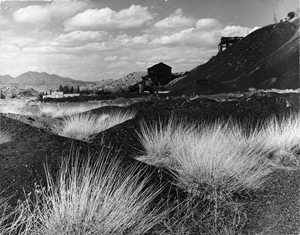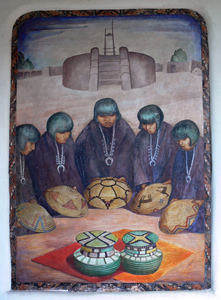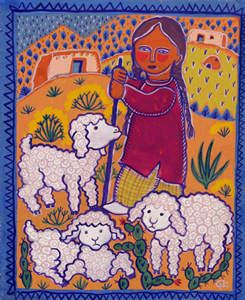New Mexico is a state located in the southwest and western regions of the United States. New Mexico is also usually considered one of the Mountain States. New Mexico is the 5th most extensive, the 36th most populous, and the 6th least densely populated of the 50 United States.
Inhabited by Indigenous peoples of the Americas for many centuries, New Mexico has also been part of the Imperial Spanish viceroyalty of New Spain, part of Mexico, and a U.S. territory. Among U.S. states, New Mexico has the highest percentage of Hispanics, including descendants of Spanish colonists and recent immigrants from Latin America. It also has the second-highest percentage of Indigenous peoples of the Americas, after Alaska, and the fourth-highest total number of Indigenous peoples of the Americas after California, Oklahoma, and Arizona. The tribes in the state consist of mostly Navajo and Pueblo peoples. As a result, the demographics and culture of the state are unique for their strong Hispanic and Native-American influences. The flag of New Mexico is represented by the red and gold colors, which represent Spain, as well as the Zia symbol, an ancient symbol for the sun of that Pueblo-related tribe.http://www.newmexico.gov/New Mexico & Great Depression
One of the hardest hit segments of the New Mexico economy during the depression was farming. In 1931, the state’s most important crops were worth only about half of their 1929 value. Dry farmers were especially devastated as they suffered from both continually high operating costs and a prolonged drought that dried up portions of New Mexico so badly that they became part of the Dust Bowl. From Oklahoma to eastern New Mexico, winds picked up the dry topsoil, forming great clouds of dust so thick that it filled the air. On May 28, 1937, one dust cloud, or “black roller,” measuring fifteen hundred feet high and a mile across, descended upon the farming and ranching community of Clayton, New Mexico. The dust blew for hours and was so thick that electric lights could not be seen across the street. Everywhere they hit, the dust storms killed livestock and destroyed crops. In the Estancia Valley entire crops of pinto beans were killed, and that once productive area was transformed into what author John L. Sinclair has called “the valley of broken hearts.”
In all parts of New Mexico, farmland dropped in value until it bottomed out at an average of $4.95 an acre, the lowest value per acre of land in the United States. Many New Mexico farmers had few or no crops to sell and eventually, they were forced to sell their land contributing in the process to the overall decline in farmland values.
In all parts of New Mexico, farmland dropped in value until it bottomed out at an average of $4.95 an acre, the lowest value per acre of land in the United States. Many New Mexico farmers had few or no crops to sell and eventually, they were forced to sell their land contributing in the process to the overall decline in farmland values.
The depression also hurt New Mexico’s cattle ranchers, for they suffered from both drought and a shrinking marketplace. As grasslands dried up, they raised fewer cattle; and as the demand for beef declined, so did the value of the cattle on New Mexico’s rangelands. Like the farmers, many ranchers fell behind in their taxes and were forced to sell their land, which was bought by large ranchers.
 Agriculture’s ailing economic condition had a particularly harsh effect on New Mexico, for the state was still primarily rural during the 1930’s, with most of its people employed in raising crops and livestock. Yet farmers and ranchers were not the only ones to appear on the list of those devastated by depressed economic conditions. Indeed, high on the list were the miners, who watched their industry continue the downward slide that had begun in the 1920’s. Many mines became the property of larger companies when conditions forced many of the smaller companies out of business. The oil industry, however, remained a bright spot in an otherwise bleak economic picture, for increased oil production provided needed tax money to the state. Tourism also received a boost when the federal government released some federal relief money to create new state parks.
Agriculture’s ailing economic condition had a particularly harsh effect on New Mexico, for the state was still primarily rural during the 1930’s, with most of its people employed in raising crops and livestock. Yet farmers and ranchers were not the only ones to appear on the list of those devastated by depressed economic conditions. Indeed, high on the list were the miners, who watched their industry continue the downward slide that had begun in the 1920’s. Many mines became the property of larger companies when conditions forced many of the smaller companies out of business. The oil industry, however, remained a bright spot in an otherwise bleak economic picture, for increased oil production provided needed tax money to the state. Tourism also received a boost when the federal government released some federal relief money to create new state parks.New Deal Programs and the Beginnings of Public Art
Taking office in March 1933, President Franklin D. Roosevelt’s New Deal relief measures were sent to Congress and within months, most of the acts the president wanted were passed. New Mexicans welcomed New Deal programs of all kinds. Some of the New Deal programs, such as the Works Progress Administration (WPA), put people to work in varying jobs: writers, artists, and musicians practiced their trades as employees of WPA projects, while others who worked for the WPA built schools and other public buildings, including the library and the administration building at the University of New Mexico. By 1936 more than thirteen thousand New Mexicans had found jobs through this program.
The financial hardships of Santa Fe painter Shuster were replicated thousands of times over among artists countrywide. In early 1933 he wrote to his good friend, New York artist John Sloan:
"Dear Sloan,
…I have been able to make all told since I returned from the homestead only $75….The merchants here…are now beginning to feel the pinch and are consequently beginning to pinch the other fellow….I am trying…to meet all my current bills and letting the old ones ride until such time as I get the cash to pay them. Yesterday I had to tell the light company to turn the…electricity off…and that I would use kerosene lamps."
…I have been able to make all told since I returned from the homestead only $75….The merchants here…are now beginning to feel the pinch and are consequently beginning to pinch the other fellow….I am trying…to meet all my current bills and letting the old ones ride until such time as I get the cash to pay them. Yesterday I had to tell the light company to turn the…electricity off…and that I would use kerosene lamps."
Shuster’s plight was shared by construction workers, clerical personnel, engineers, teachers, merchants – America’s working class – as well. His words admitted the reality of a bleak and frightening future for the U.S. community at large.
For the artist, the collapse of the stock market equated the collapse of the art market: art collectors and patrons, now without stock dividend income that provided the means for the acquisition of ‘luxury’ items, could not purchase art. The romance of the ‘starving artist’ took on urgent and less than romantic connotation – and warning.
In December,1933, Shuster wrote his friend again, but this letter was one of ebullience and optimism: “The most important thing which has happened to the Shuster family is this Federal Art Project. Forty two fifty a week from the Government for painting. My God it doesn’t seem real.” (It is interesting to note that a weekly wage of $42.50 in 1933 was the equivalent of $472.00 per week in 1992.)
“The most important thing which has happened to the Shuster family is this Federal Art Project. Forty two fifty a week from the Government for painting. My God it doesn’t seem real.” (It is interesting to note that a weekly wage of $42.50 in 1933 was the equivalent of $472.00 per week in 1992.)
In the letter Shuster explained his proposal for three projects one of which Shuster ultimately painted pictures of the Carlsbad Caverns, which were acquired by the National Park Service, and presently hang in the Western Archaeological Conference Center in Tucson, Arizona. He was awarded a second Public Works of Art Project (PWAP) project: to paint murals on the wall of the enclosed patio of the Museum of Fine Arts, in Santa Fe.
 “The most important thing which has happened to the Shuster family is this Federal Art Project. Forty two fifty a week from the Government for painting. My God it doesn’t seem real.” (It is interesting to note that a weekly wage of $42.50 in 1933 was the equivalent of $472.00 per week in 1992.)
“The most important thing which has happened to the Shuster family is this Federal Art Project. Forty two fifty a week from the Government for painting. My God it doesn’t seem real.” (It is interesting to note that a weekly wage of $42.50 in 1933 was the equivalent of $472.00 per week in 1992.)In the letter Shuster explained his proposal for three projects one of which Shuster ultimately painted pictures of the Carlsbad Caverns, which were acquired by the National Park Service, and presently hang in the Western Archaeological Conference Center in Tucson, Arizona. He was awarded a second Public Works of Art Project (PWAP) project: to paint murals on the wall of the enclosed patio of the Museum of Fine Arts, in Santa Fe.
The PWAP was the first federally funded art program under the Civil Works Administration (CWA) – a New Deal work-relief program created by President Roosevelt to alleviate the economic job crisis. In time, all the federal art projects have come to be generically referred to as “WPA Art,” (Works Progress Administration, or WPA).
The CWA was administered by socially conscious Harry Hopkins whose heartfelt belief was that “artists have to eat like other people.” The PWAP started in December 1933 and continued until June 1934, and was the brainchild of artist George Biddle, a former schoolmate of President Roosevelt at Groton and Harvard. An advocate of mural art in America, Biddle had studied with the Mexican muralist, Diego Rivera, and it was his belief that Rivera and others gave voice to the social ideals of the Mexican Revolution of 1910 through their vivid, colorful murals. It would follow, he believed, that murals painted by American artists in the United States would be appropriate vehicles for the expression of the ideals of Roosevelt’s New Deal. Murals painted by Biddle and New Mexico’s Emil Bisttram may be seen today in the Department of Justice Building in Washington DC.
 Between 1933 – 1943, in the depth of the depression, 167 known artists lived in New Mexico, all struggling to sell art in a time when many Americans had little money available even for necessities. The New Deal’s Works Progress Administration Art Project provided an opportunity for artists to create artwork for public buildings, allowing them to remain independent, support their families, and enrich and enhance the community.
Between 1933 – 1943, in the depth of the depression, 167 known artists lived in New Mexico, all struggling to sell art in a time when many Americans had little money available even for necessities. The New Deal’s Works Progress Administration Art Project provided an opportunity for artists to create artwork for public buildings, allowing them to remain independent, support their families, and enrich and enhance the community.
 Between 1933 – 1943, in the depth of the depression, 167 known artists lived in New Mexico, all struggling to sell art in a time when many Americans had little money available even for necessities. The New Deal’s Works Progress Administration Art Project provided an opportunity for artists to create artwork for public buildings, allowing them to remain independent, support their families, and enrich and enhance the community.
Between 1933 – 1943, in the depth of the depression, 167 known artists lived in New Mexico, all struggling to sell art in a time when many Americans had little money available even for necessities. The New Deal’s Works Progress Administration Art Project provided an opportunity for artists to create artwork for public buildings, allowing them to remain independent, support their families, and enrich and enhance the community.
The following New Mexico artists were among the many employed in WPA projects: Pablita Velarde, Maria Martinez, Ila McAfee, Gerald Cassidy, Will Shuster, Lloyd Moylan, Gisella Loeffler, Eliseo Rodriguez, Kenneth Adams, Fremont F. Ellis and Peter Hurd. The area coordinator of the WPA’s Public Works of Art Project was woodblock printer, painter and marionette-maker Gustave Baumann, a leading member of the Santa Fe art community. More than 65 murals with varied subject materials were created in New Mexico during the Depression. In addition to these murals, the WPA sponsored more than 650 paintings, ten sculptural pieces, and numerous indigenous Hispanic Native American crafts.
My own knoledge
I had been reading about that difficult situation in USA and in New Mexico. I learned that from crisis mostly suffered farmers, because ground was very dry. Goverment of United States had no ability to help them, because country hadn`t any money. So a lot of people who were employed in farming were doomed on a hungry deth.
New Deal helped them by giving alternitive job in libreries, museums, etc... Also, it gave money to farmers who produced less agriculture and meat production - every can take that money because nobody produced much.
Немає коментарів:
Дописати коментар